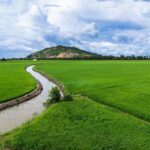Introduction explained
Introduction and Environmental and Economic Impacts
The Great Salt Lake: A Vital Ecosystem in Peril
The Great Salt Lake, a vital ecosystem and a crucial resource for the surrounding region, is facing a severe water crisis. Climate change, coupled with unsustainable water usage, has led to a drastic decline in lake levels, threatening the delicate balance of this unique environment.
A Collaborative Approach to Restoration
Addressing this challenge requires a multifaceted and collaborative approach. By understanding the complex hydrological processes that influence the lake’s water levels, recognizing the impacts of climate change, and implementing sustainable water management practices, we can work towards restoring the Great Salt Lake’s health.
The Active Climate Rescue Initiative
The Active Climate Rescue Initiative is dedicated to addressing this critical issue. Through their efforts, they are working to:
- Conserve Water: Promote water conservation measures in homes, businesses, and agricultural practices.
- Optimize Water Usage: Explore innovative irrigation technologies and sustainable water use strategies for agriculture.
- Advocate for Smart Policies: Support policies that promote water conservation and prioritize the health of the Great Salt Lake.
A Call to Action
Restoring the Great Salt Lake requires a collective effort. By understanding the challenges, embracing sustainable practices, and supporting organizations like the Active Climate Rescue Initiative, we can protect this invaluable natural resource for future generations.
The Great Salt Lake: A Sea of Trouble
TL;DR – The Great Salt Lake is facing a big water problem! Climate change is making it hotter and drier, which means less water flows into the lake. This is causing the lake to shrink and harming plants, animals, and people who rely on it. To save the lake, we need to use water wisely, find new ways to water crops, and make smart decisions about how much water we use.
The Great Salt Lake’s Water Journey
The Great Salt Lake, located in Utah, is a fascinating natural wonder. But it’s also facing a serious challenge: water shortages. To understand this challenge, we need to understand how water moves through the region.
Imagine a giant bathtub. The water flowing into the Great Salt Lake is like the faucet being turned on. Rivers like the Jordan River and the Bear River bring water from the mountains and the surrounding areas. Rain and snow also add to the lake’s water supply.
The Rich County area in northeastern Utah is a key player in this water cycle. It’s a mountainous region with lots of snow, which melts in the spring and summer, feeding the rivers that flow into the Great Salt Lake. But lately, things haven’t been flowing as smoothly.
The Shrinking Lake: A Sign of Trouble
The Great Salt Lake is shrinking. It’s like the bathtub is draining faster than it’s being filled. This is happening because of climate change, which is causing the region to get hotter and drier. Less snow falls in the mountains, and the snow melts faster. This means there’s less water flowing into the Great Salt Lake.
The shrinking lake is a big problem for many reasons. It’s harming the plants and animals that depend on the lake for food and shelter. The air quality is getting worse because the dry lakebed is blowing dust into the air. And the lake’s shrinking is also a problem for the economy, since it affects tourism and industries that rely on the lake’s resources.
Finding Solutions: Saving the Great Salt Lake
There’s hope for the Great Salt Lake! Here are some ways we can help bring back its water levels:
Water Conservation
Just like we need to conserve energy, we need to conserve water. That means using water wisely. We can do this by fixing leaky faucets, taking shorter showers, and watering our lawns less often.
Innovative Irrigation
Farmers use lots of water to grow crops. We can help the Great Salt Lake by finding new ways to water crops using less water. This could include using drip irrigation, which delivers water directly to the roots of plants, or using water-efficient crops that need less water to grow.
Policy Measures
Our leaders need to make smart decisions about how we use water. This could include setting limits on how much water we can use, or creating incentives for people and businesses to conserve water.
Fighting for the Future: Active Climate Rescue Initiative
The Active Climate Rescue Initiative is an amazing group working to solve the water shortage crisis in the Great Basin, which includes the Great Salt Lake. They are working to develop innovative solutions and raise awareness about this important issue.
A Summary of Hope and Action
The Great Salt Lake is facing a big challenge, but there’s hope! By understanding how water moves through the region, recognizing the impact of climate change, and working together to conserve water, use water wisely, and implement smart policies, we can help restore the Great Salt Lake and protect its precious resources.
More on Introduction…
- ## SEO Keywords related to ‘Introduction’ and/or ‘Environmental and Economic Impacts’
- General:
- Introduction
- Environmental impact
- Economic impact
- Sustainability
- Environmental sustainability
- Economic sustainability
- Social impact
- Triple bottom line
- ESG (Environmental, Social, and Governance)
- Corporate social responsibility
- Sustainable development
- Global impact
- Community impact
- Environmental justice
- Specific to Environmental Impacts:
- Climate change
- Greenhouse gas emissions
- Pollution
- Water pollution
- Air pollution
- Land degradation
- Deforestation
- Biodiversity loss
- Resource depletion
- Renewable energy
- Sustainable agriculture
- Waste management
- Carbon footprint
- Ecological footprint
- Environmental regulations
- Specific to Economic Impacts:
- Economic growth
- Job creation
- Investment
- Innovation
- Market share
- Consumer behavior
- Supply chain
- Cost savings
- Profitability
- Economic development
- Poverty reduction
- Inequality
- Business ethics
- Fair trade
- Specific to Introductions:
- Introduction to [topic]
- Overview of [topic]
- Background information
- Context
- Defining [term]
- Key concepts
- Scope of [topic]
- Thesis statement
- Introduction paragraph
- Introductory sentence
- Combinations:
- Environmental and economic impacts of [topic]
- Introduction to environmental and economic impacts
- Sustainable business practices
- Green economy
- Circular economy
- Ethical consumption
- Impact investing
- Sustainable finance
- Greenwashing
- Environmental stewardship
- Economic resilience
- Climate-smart agriculture
- Sustainable tourism
- Long-Tail Keywords:
- How does [topic] affect the environment?
- What are the economic consequences of [topic]?
- The environmental impact of [product/service]
- The economic benefits of sustainable practices
- Introduction to the environmental and economic impacts of [industry]
- The role of [organization/policy] in mitigating environmental and economic impacts
- Note:** These keywords can be further customized by adding specific industries, products, services, or locations. For example, “environmental impact of plastic production” or “economic impact of tourism in Thailand.”











